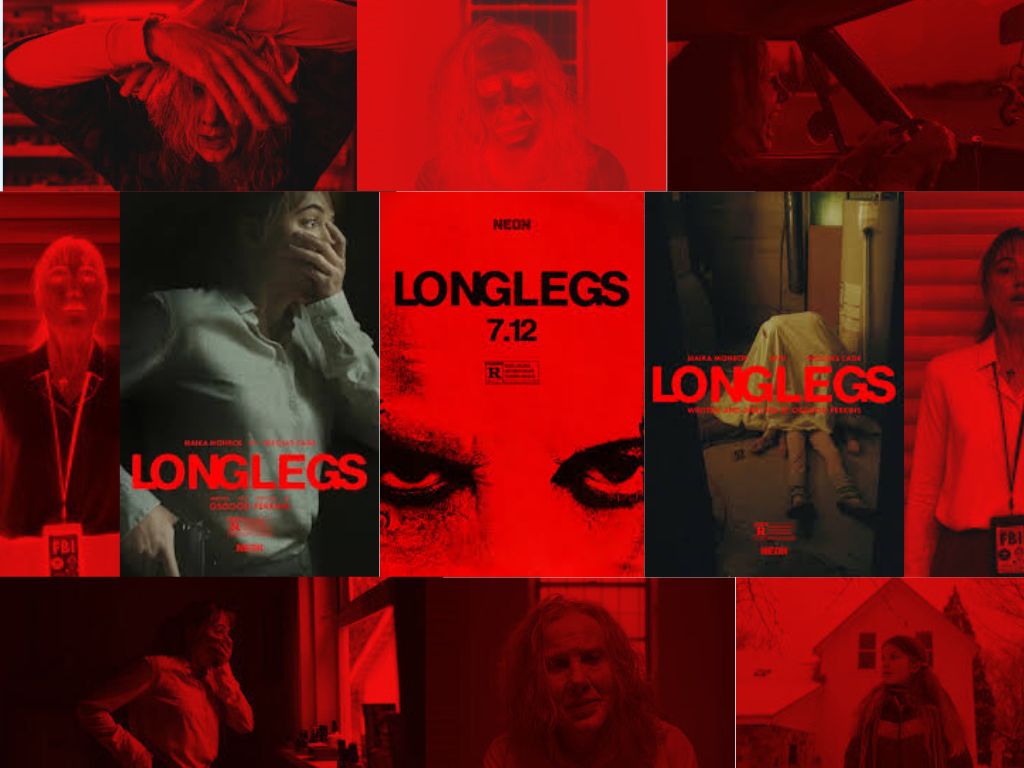Score: 4/5 stars
Some horror crawls under your skin and stays there longer than you’d like.
This description aptly fits Oz Perkins’ latest horror film, Longlegs, a modern classic in stylistic horror filmmaking that doesn’t fully compromise substance for an immersive audiovisual experience.
The film’s story follows FBI agent Lee Harker (Maika Monroe) as she is tasked with uncovering information about a series of family murder-suicides connected to the enigmatic serial killer “Longlegs” (Nicholas Cage). Further information about the case points her towards the occult, complicating the task of uncovering Longlegs’ true identity and his motivations behind the string of grisly murders.
First, the elephant in the room: claims have circulated that Longlegs is, hyperbolically, “the scariest movie of all time.” It’s not, but as far as recent horror releases go, a strong case can be made for it being in the verifiably scary camp.
The marketing team at NEON Rated achieved groundbreaking work building hype around the film from the ground up. In winter of this year, various teasers were released with cryptic imagery and characters of an unknown cypher. None of the promotional material ever revealed Cage’s appearance as the titular character, further building anticipation and paying off tremendously when you finally see him.
Longlegs is certainly a scary film, but it’s far less aggressive than the marketing makes it seem. It begins as a stylistic police-procedural thriller, the plot slowly introducing a more sinister mood. The horror largely lies in the atmosphere; the paranoid feeling of being stalked. Longlegs’ presence is felt throughout the entire movie, always leaving hints that he is watching events unfurl.
The performances are stellar all around. Monroe delivers a steely performance as Agent Harker, showing her ability to disappear into a role characterized by aloofness and inner turmoil.
Cage’s performance is probably the biggest love-it-or-hate-it aspect of the entire film. Concealing his appearence in the marketing gave a shock-value boost for his success here, but his general creepiness as Longlegs is a dominating force onscreen that commands attention and cannot be understated. However, an eccentric, chaotic performance like this will confirm to viewers whether they’re fully immersed in the film or pulled out of it entirely. And, as established, the film already depends heavily on the immersion aspect to be effectively scary.
Despite having only a handful of feature films under his belt, Perkins clearly has a vision of what he wants to bring to horror cinema. His commitment to consistent aestheticism is comparable to Ari Aster’s work in Hereditary and Midsommar.
What sets Perkins apart is the general bleakness of his films. Longlegs is a visually stunning film, demonstrating Perkins’ ability to control the mood, but it doesn’t possess the same illusion of security that Aster’s films do. Both Longlegs and his previous film The Blackcoat’s Daughter are openly bleak, wintertime horror, relishing in the gloom of the sun setting a little earlier.
He holds the camera on uncomfortably long, wide shots to drive the imagination wild. You’re constantly anticipating something to appear just in the corner of the frame, and when something does, the film only further sinks its teeth into you. It’s a classic rumination on whether it’s scarier to be alone or not alone in the dark; the feeling of being alone in the woods at night and wondering what could be out there watching you, hidden from view.
That’s the thing about this brand of atmospheric horror; it doesn’t rely on the immediacy of jump scares to get under your skin, though the few it does use are shocking, full-body scares.
Picture yourself in bed late at night. You switch the lights off and anticipate the quiet pattering of rain on your window to lull you to sleep. Before sleep can swallow you, your eyes notice a shadowy mass hunched in the corner of your room, watching. After a minute of staring at it, your eyes convince you that its body is rising and falling with its breath. Your tired eyes picture it slowly standing up, the uncanny, humanoid form glaring down at you.
Surely this would raise anyone’s heart rate, if not for the moment you turn on a light and you’re met with the unruly sight of the dirty laundry you procrastinated.
While the atmosphere of Longlegs may feel suffocating, it doesn’t take much to see through the shadowy front and exit the trance it puts you in. Whether or not it’s effective in scaring audiences is entirely dependent on their decision to entertain the things that go bump in the night.
The film’s clear attention to style tests our ability to intuitively feel when something isn’t quite right in a space, but it’s by no means a film that neglects narrative substance to maintain its aesthetic orientation. What Longlegs succeeds at imprinting on audiences is a chilling reminder of evil’s presence in our world.
You’re led to believe it’s lurking just out of sight — the beady eyes you feel on your back as you flick off the basement light, climbing the steps to the safety of the main floor — but it’s always been within arm’s reach. Even if you give yourself time to notice it, how long is there before it’s too late to do anything? In other words, don’t forget to check under your bed before you nod off tonight.

